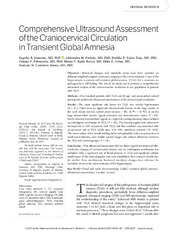Prikaz osnovnih podataka o dokumentu
Comprehensive Ultrasound Assessment of the Craniocervical Circulation in Transient Global Amnesia
| dc.creator | Jovanovic, Zagorka B. | |
| dc.creator | Pavlović, Aleksandra M. | |
| dc.creator | Vujisic Tesic, Bosiljka P. | |
| dc.creator | Pekmezovic, Tatjana P. | |
| dc.creator | Kostic Boricic, Marija V. | |
| dc.creator | Cvitan, Edita Z. | |
| dc.creator | Covickovic Sternic, Nadezda M. | |
| dc.date.accessioned | 2023-02-09T13:13:25Z | |
| dc.date.available | 2023-02-09T13:13:25Z | |
| dc.date.issued | 2018 | |
| dc.date.issued | 2017 | |
| dc.identifier.issn | 1550-9613 | |
| dc.identifier.uri | https://onlinelibrary.wiley.com/doi/abs/10.1002/jum.14355 | |
| dc.identifier.uri | C:\Users\FASPER\Zotero\storage\E5J8QD4U\Jovanovic et al. - 2018 - Comprehensive Ultrasound Assessment of the Cranioc.pdf | |
| dc.identifier.uri | http://rfasper.fasper.bg.ac.rs/handle/123456789/5028 | |
| dc.description.abstract | Objectives Structural changes and metabolic stress have been reported on diffusion-weighted magnetic resonance imaging in the cornu ammonis 1 area of the hippocampus in patients with transient global amnesia (TGA), but a consensus on pathogenesis is still lacking. The aim of our study was to perform a comprehensive ultrasound analysis of the cerebrovascular circulation in our population of patients with TGA. Methods One hundred patients with TGA and 50 age- and sex-matched control participants underwent ultrasound examinations of the cervicocranial circulation. Results The most significant risk factor for TGA was arterial hypertension (P < .01). There were no significant atherosclerotic lesions on the large arteries of the neck (mean internal carotid artery stenosis ± SD, 28.7% ± 11.7%) or on the large intracerebral arteries (good structural and hemodynamic status; P > .05). Rarely detected microembolic signals or a right-left cardiopulmonary shunt excluded an emboligenic mechanism of TGA (P > .05). The internal jugular vein valves were incompetent in 54% of patients with TGA, and this condition was associated with an increased risk of TGA (odds ratio, 4.16; 95% confidence interval, 1.91–9.04). The mean values of the breath holding index and pulsatility index, as parameters of small-vessel function, were within normal ranges and without differences between the TGA and control groups (P > .05). Conclusions Our ultrasound examination did not detect significant structural atherosclerotic changes of cervicocranial arteries, and an emboligenic mechanism was excluded. Only a significant rise of blood pressure in TGA and significant valvular insufficiency of the internal jugular vein were established. New research should clarify whether these simultaneous functional circulatory changes have relevance for metabolic stress in the cornu ammonis of the hippocampus. | |
| dc.language | en | |
| dc.publisher | Wiley | |
| dc.rights | openAccess | |
| dc.rights.uri | https://creativecommons.org/licenses/by/4.0/ | |
| dc.source | Journal of Ultrasound in Medicine | |
| dc.subject | head and neck | |
| dc.subject | neurosonology (adult) | |
| dc.subject | transient global amnesia | |
| dc.subject | ultrasound examination | |
| dc.subject | vascular (access) | |
| dc.subject | head and neck | |
| dc.subject | neurosonology (adult) | |
| dc.subject | transient global amnesia | |
| dc.subject | ultrasound examination | |
| dc.subject | vascular (access) | |
| dc.title | Comprehensive Ultrasound Assessment of the Craniocervical Circulation in Transient Global Amnesia | |
| dc.type | article | en |
| dc.rights.license | BY | |
| dc.citation.epage | 486 | |
| dc.citation.issue | 2 | |
| dc.citation.spage | 479 | |
| dc.citation.volume | 37 | |
| dc.identifier.doi | 10.1002/jum.14355 | |
| dc.identifier.fulltext | http://rfasper.fasper.bg.ac.rs/bitstream/id/9917/bitstream_9917.pdf | |
| dc.identifier.wos | 000422864000018 | |
| dc.type.version | publishedVersion |


